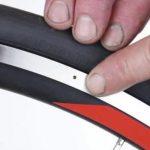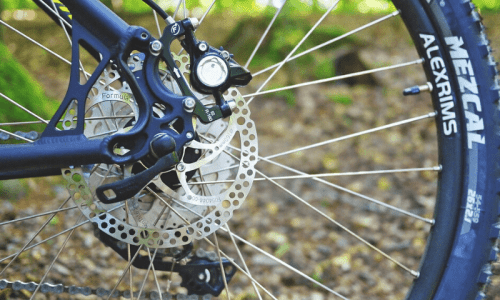ALUMINUM RIMS

Several times during the year, its a great idea to check your rims for wear. Each time the brake pads come into contact with the rim’s braking surface, a little rim material is abraded away. After a while, the rim will have a concave channel cut into it from the brake pads.
The picture to the right shows this result when holding a flat edge to the side of a worn out rim. The real issue here is SAFETY. When rims get this worn, i.e., this far past their intended life, there is very little structural material remaining to hold the rim together.
Not only is there 100psi or so pushing out from the inside, the rim takes a lot of abuse and shock from running over bumps in the road as well as flexing under load. This can easily cause a catastrophic failure of a worn out rim causing the rider to be launched hard into the ground.

Most wheel manufacturers drill a small wear indicator hole into the rim (see photo to the right) so you can quickly determine when your rim is worn past this safety point. When the indicator hole disappears, its time for a new rim or a new set of wheels.
Usually its best to get a new set of wheels especially if you have one of the minimally-spoked/high tensioned wheels which are somewhat difficult to rebuild correctly to a new condition.
Also, with trickle-down technology, you can probably get a higher quality wheel at a lower cost than your current wheels.
From cyclist to cyclist, there will be a great discrepancy between how many miles are ridden as to when its time to replace the rim (wheels). Here are some examples;
- Weight Matters – Heavier riders will wear out rims faster than lighter riders since the heavier riders will need to apply more force to the brakes to slow down the bicycle than a lighter rider will.
- Hills vs Flats – Those who train a lot on hills will wear out their rims out much faster than those who ride only flat roads since brakes are applied quite often when descending long-steep hills.

A couple of examples of what can happen when too much of the rim material is worn away. - Material Matters – The metallurgical makeup of the rim will also impact the amount of miles the rim will allow. Cheap aluminum rims will wear out much more quickly than highly-alloyed aluminum and/or aluminum-scandium rims.
- Brake Pad Composition – Make sure you are using a high quality brake pad that is recommended by the manufacturer.
- Brake Pad Age – Brake pads get harder over time and real old pads can be very hard (and hard on the rims). Softer (newer) pads will wear quicker thereby reducing the wear on the rim.
- Clean your Brake Pads – Click here to see our previous blog.
- Keep the Rims Clean – An old green scouring pad with some Simple Green or some hot soapy water works great. Clean your rims before or after each ride.
So bottom line is … for safety’s sake, check your rims every month or so.
CARBON RIMS
Some questions came in regarding carbon rims. “How do I know when my full carbon rim is worn out?”
First off, my belief is that carbon rims/wheels should ONLY BE USED FOR RACING PURPOSES! Aluminum alloys make far superior wheels for general riding and training. Click here to see our other article on this topic…
Second, Carbon clinchers are still heavier than a high quality aluminum/scandium clincher such as Shimano’s Dura-Ace 9000 C-24.
Carbon Fiber clincher wheels are usually carbon wrapped aluminum, tubulars can be full carbon fiber. They both have the same thing in common – a carbon fiber braking surface. So how do you know when its worn to the point of the rim/wheel needing replacing?
Short Answer: Carbon Fiber Rims are unlikely to wear out before other factors destroy them.

After talking with several of the carbon wheel manufacturers as well as several high-end wheel builders, here is the low-down.
- You need to run the correct manufacturer recommended brake pads. These ‘carbon fiber rim specific’ pads cost 3-4 times that of a high quality regular brake pad such as the Dura Ace 9000 brake pad.
- Advantage – Aluminum Rims
- You need to clean the carbon rims OFTEN using a 3M Scotch-Brite green pad using Acetone.
- Advantage – Aluminum Rims
- Carbon Fiber is very sensitive to heat. Heat can cause the resin to fail and the rim to start delaminating. Therefore, they don’t make the best climbing/descending wheels.
- Advantage – Aluminum Rims
- Carbon Fiber Clincher wheel sets are usually 100+ grams heavier than a high quality aluminum-scandium wheel set. Therefore, they don’t make the best climbing/descending wheels.

Heat delamination
click for full size photo- Advantage – Aluminum Rims
- Carbon Fiber Clincher Wheel sets are usually 2+X the price of a high quality aluminum-scandium wheel set.
- Advantage – Aluminum Rims
- Carbon Fiber Wheel sets are much more prone to crash damage than a high quality aluminum-scandium wheel set.
- Advantage – Aluminum Rims

Cracked Carbon Fiber Rim So, based on the above, are you still sure you want a carbon fiber clincher wheel set? Compared to a clincher, they are heavier, cost more, more difficult to care for, more prone to damage, don’t climb/descend as well and therefore have a shorter lifespan.
So then, you ask, how about tubulars? Again, my answer is … for racing only. Not the best choice for a training wheel due to the susceptibility of getting a flat and having to change a tubular tire. Difficult at best.
Stick with a high-quality lightweight clincher wheel set and check the wear indicator often.

I have always enjoyed bicycling and, through a series of coincidences, became a Bicycle Industry Consultant and Product Tester. I test prototype products for companies and have published only off the shelf production products on biketestreviews.com.






